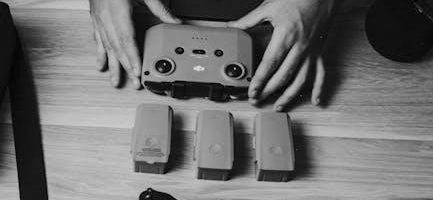Welcome to the E88 Drone Manual! This guide provides essential information for safe and effective operation of your drone, covering features, setup, and flight tips.
1.1 Understanding the E88 Drone and Its Features
The E88 Drone is a versatile and feature-rich quadcopter designed for both beginners and experienced pilots. It boasts a 4K camera for high-quality photography and videography, foldable arms for easy portability, and a user-friendly app control system via Wi-Fi. The drone supports FPV (First-Person View) for real-time transmission and includes advanced features like one-key return, headless mode, and 360-degree stunt capabilities. Its compact design, combined with intuitive controls, makes it an ideal choice for capturing stunning aerial footage and enjoying thrilling flights. The RC FPV app enhances flight control and connectivity, ensuring a seamless experience for all users.
1.2 Importance of Reading the Manual
Reading the E88 Drone Manual is essential for safe and effective operation. It provides critical information on safety precautions, proper setup, and troubleshooting. The manual details how to handle the drone, charge the battery, and understand its features. It also covers legal considerations and maintenance tips. By following the guidelines, users can ensure optimal performance, extend the drone’s lifespan, and avoid potential hazards. This manual serves as a comprehensive guide for both new and experienced operators, helping them make the most of their flying experience while adhering to safety standards.
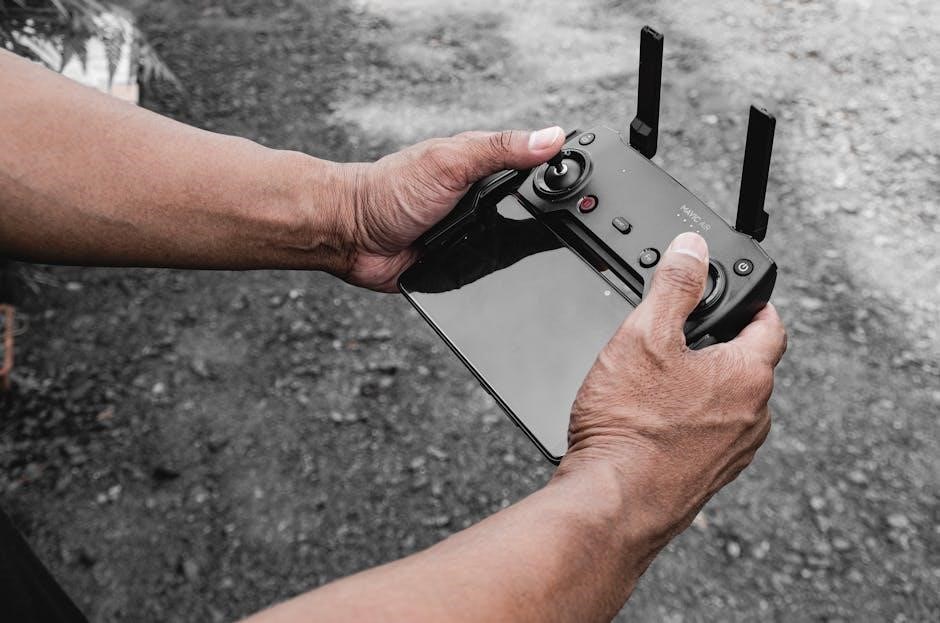
Safety Information and Precautions
Ensure safe operation by following guidelines. The E88 drone is not suitable for children under 14 and requires adult supervision. Properly dispose of electronic waste.
2.1 General Safety Guidelines
Always follow safety guidelines to ensure safe drone operation. The E88 drone is not suitable for children under 14 and requires adult supervision. Avoid flying near people, animals, or obstacles. Do not fly in bad weather conditions. Keep the drone away from small children due to choking hazards from small parts. Only use original charging equipment to prevent damage. Properly dispose of electronic waste according to local regulations. Follow all manufacturer instructions and local laws for safe and responsible flying.
2.2 Age Restrictions and Supervision
The E88 drone is recommended for users aged 14 and above. Children under 14 must use the drone under adult supervision. Small parts pose a choking hazard, so keep them out of reach of young children. Ensure first-time users are adults to guarantee proper handling and safety. Always adhere to the manufacturer’s guidelines to prevent accidents and ensure responsible usage. Supervision is crucial to teach safe flying practices and comply with local regulations.
2.3 Proper Disposal of Electronic Waste
Dispose of the E88 drone and its components responsibly. Electronic waste requires special handling to protect the environment. Recycle batteries, propellers, and other parts according to local regulations. Avoid landfill disposal to prevent hazardous materials from harming ecosystems. Check local e-waste collection centers for proper recycling methods. Ensure safe disposal to minimize environmental impact and promote sustainability. Proper disposal helps conserve natural resources and reduces pollution risks associated with electronic devices.
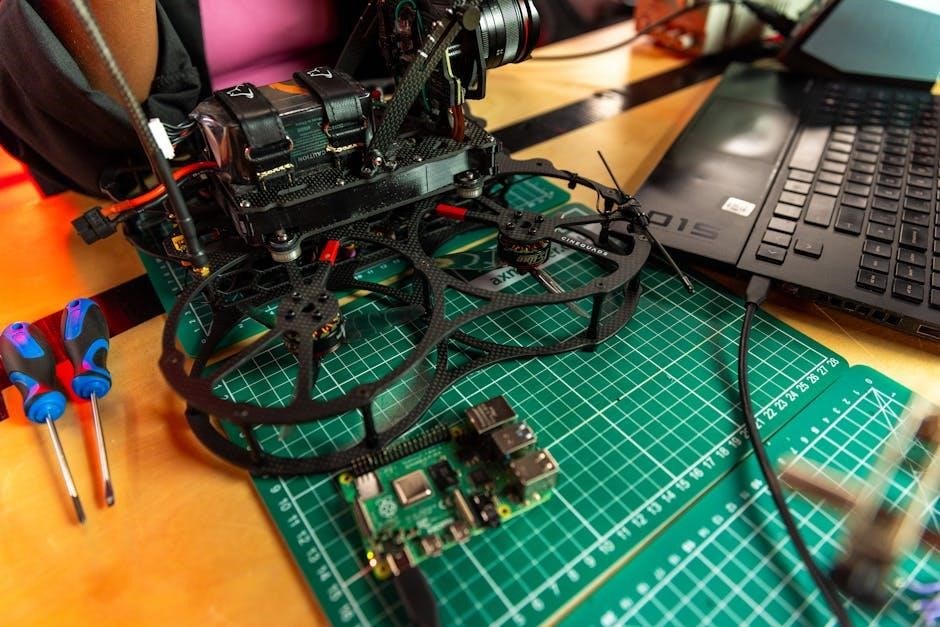
Unboxing and Inventory
Upon unboxing, verify all components: drone, remote controller, battery, charger, propellers, and user manual. Ensure no parts are missing or damaged before proceeding.
3.1 Items Included in the Box
Inside the box, you’ll find the E88 drone, a remote controller, a rechargeable battery, a USB charging cable, and a user manual. Additionally, there’s a protective carrying case, four spare propellers, and a set of Allen wrenches for adjustments. Some versions may include a phone holder for the remote controller and a SD card for storing photos and videos. Ensure all items are present and undamaged before proceeding with setup.
3.2 Checking for Damage or Missing Parts
Before proceeding, carefully inspect all items for damage. Ensure the drone, remote controller, battery, USB cable, and propellers are included and undamaged. Verify the user manual is present for guidance. Check for any signs of physical damage, such as dents or cracks, and ensure all accessories are accounted for. If any parts are missing or damaged, contact customer support immediately to resolve the issue before attempting to use the drone.
Setting Up the Drone
Install the battery in the remote controller and charge the drone battery. Complete initial setup, ensuring all components are properly connected and functioning as instructed in the manual.
4.1 Installing the Battery in the Remote Controller
To install the battery, open the battery compartment on the remote controller’s rear. Insert 3×1.5V AA batteries, ensuring correct polarity. Avoid using mixed or non-rechargeable batteries. The charging time is approximately 120 minutes. Once installed, close the compartment securely. This step ensures proper power supply for the remote controller, enabling smooth communication with the drone during operation. Always follow safety guidelines to avoid damage or malfunction.
4.2 Charging the Drone Battery
To charge the drone battery, remove it from the drone and connect it to the provided USB cable. Plug the USB end into a compatible power source. The charging indicator will show a red light, turning green when fully charged. Charging typically takes 120 minutes. Avoid overcharging to maintain battery health. Ensure the drone is turned off during charging for safety. Proper charging ensures optimal performance and extends the battery’s lifespan. Always follow the manufacturer’s guidelines for safe charging practices.
4.3 Initial Drone Setup and Checks
After charging, ensure all components are securely attached. Check the propellers for damage and proper installation. Power on the drone and wait for the lights to stabilize. Perform a quick calibration by following the on-screen instructions in the RC FPV app. Ensure the remote controller is paired correctly with the drone. Conduct a pre-flight check to verify all systems are functioning properly. This setup ensures a safe and smooth first flight experience, allowing you to familiarize yourself with the drone’s controls and features effectively.
Understanding the Remote Controller
Explore the remote controller’s layout and functions to master precise control of the E88 Drone, ensuring a smooth and enjoyable flight experience with key customizable settings.
5.1 Remote Controller Layout and Functions
The remote controller features a ergonomic design with dual joysticks, a power button, and function buttons for mode switching. The left joystick controls throttle and yaw, while the right joystick manages pitch and roll. The power button powers on the controller, and function buttons access features like headless mode and return-to-home. An LCD screen displays real-time flight data, including battery level and signal strength. Understanding these components is crucial for precise control and safe operation of the E88 Drone.
5.2 Pairing the Remote Controller with the Drone
To pair the remote controller with the E88 Drone, power on both devices. The drone’s lights will flash, indicating it is in pairing mode. Move the left joystick on the controller to the bottom and back to the top to initiate pairing. Once synced, the drone will beep and the lights will stabilize. Ensure both devices are fully powered and within range for a successful connection. Proper pairing is essential for controlling the drone effectively during flights.

Flying the Drone for the First Time
Turn on the drone and ensure the remote controller is paired. Find an open, safe space and begin with basic movements to get familiar with the controls.
6.1 Calibrating the Drone
Before your first flight, ensure the drone is calibrated. Place it on a flat surface, power it on, and follow the remote controller’s calibration prompt. Press and hold the joysticks as instructed to complete the process. Calibration ensures stable flight by aligning the drone’s gyroscope. Avoid moving the drone during calibration. Once complete, the drone will beep to confirm. Proper calibration is essential for smooth and controlled flight performance. Always recalibrate if the drone is moved or exposed to strong magnetic fields.
6.2 Basic Flight Controls and Movements
The left joystick controls the drone’s throttle (up/down) and yaw (left/right rotation). The right joystick manages pitch (forward/backward) and roll (left/right movement). Start in an open area, power on the drone, and ensure it’s calibrated. Gently move the joysticks to practice basic movements. Use slow, precise motions for stability. Familiarize yourself with the controls before attempting advanced maneuvers. Always maintain visual contact with the drone during flight to ensure safe operation and precise control.
6.3 Understanding Flight Modes
The E88 drone offers multiple flight modes to enhance your experience. Sport Mode increases speed for advanced users, while Altitude Hold maintains steady height. Headless Mode simplifies control by aligning the drone’s front with the pilot. To switch modes, use the designated button on the remote. Each mode provides unique benefits, allowing you to tailor your flight to skill level or objective. Practice in open areas to master these modes and ensure smooth, enjoyable flights.
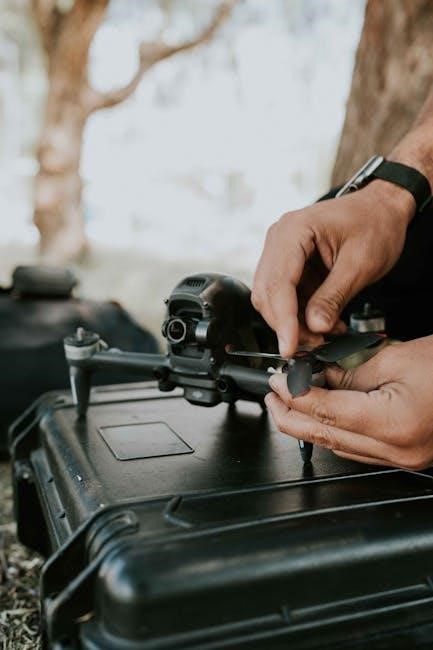
Advanced Features of the E88 Drone
Explore the E88 Drone’s advanced features, including Headless Mode for easy control, 360-Degree Stunts for aerobatics, and One-Key Return for safe landings, enhancing your flight experience.
7.1 Headless Mode and Its Benefits
Headless Mode simplifies drone operation by aligning the drone’s movement with the pilot’s perspective, eliminating orientation challenges. Activate it by pressing a button or moving the remote control sticks. This mode is ideal for beginners, as it reduces confusion and makes flights more intuitive. The drone’s lights will flash to confirm entry into Headless Mode, ensuring a seamless experience. This feature enhances control, making it easier to navigate and capture footage without worrying about the drone’s direction.
7.2 Performing 360-Degree Stunts
Performing 360-degree stunts with the E88 drone adds excitement to your flights. To execute this maneuver, press the stunt button on the remote control or move the right joystick in a circular motion. Ensure the drone is at a safe altitude and clear of obstacles. The drone will perform a smooth rotation, capturing dynamic footage. Practice in open spaces to master this feature and enhance your aerial photography skills with stunning spins and turns.
7.3 Using the One-Key Return Function
The one-key return function simplifies bringing your E88 drone back to its starting point. Press and hold the return button on the remote control until the drone confirms the command. The drone will ascend to a safe altitude, calculate its route, and fly back autonomously. This feature is especially useful for beginners or in low-visibility conditions. Ensure the drone has a clear path to avoid obstacles during its return journey. This function enhances safety and convenience, making flight recovery effortless.
Camera and Imaging
The E88 drone features a 4K camera, capturing high-resolution photos and videos. It allows for wide-angle shots and stable footage, ideal for aerial photography and videography.
8.1 Understanding the 4K Camera
The E88 Drone is equipped with a high-quality 4K camera, designed to capture stunning aerial photos and videos. With a wide-angle lens and impressive resolution, it ensures clear and detailed imagery. The camera supports various shooting modes, including video recording and time-lapse photography. To get the best results, ensure the camera is securely attached and the drone is stable during operation. Regularly clean the lens to maintain image quality and avoid capturing blurry footage.
8.2 Connecting the Drone to Your Phone via WiFi
To connect your E88 Drone to your phone, download and install the RC FPV app from the App Store or Google Play. Once installed, enable WiFi on your phone and select the drone’s network from the available options. Open the app and follow the in-app instructions to complete the pairing process. Ensure the drone is powered on and in range for a stable connection. This setup allows you to view real-time video, control the camera, and access advanced flight features directly from your phone.
8.3 Tips for Capturing High-Quality Footage
For high-quality footage, ensure the camera is securely attached and adjust settings like resolution and frame rate in the RC FPV app. Fly in well-lit environments, avoiding direct sunlight for optimal clarity. Use the drone’s stabilization features to minimize shake and blur. Experiment with angles and heights to capture dynamic shots. Regularly clean the lens to prevent smudges or debris from affecting video quality. Practice smooth, steady movements with the remote controller to achieve professional-looking results.

Maintenance and Care
Regularly clean the drone and camera lens to ensure optimal performance. Store the drone in a dry, cool place to preserve battery life and components. Always use the original charger for safe charging and to prevent damage. Check and replace propellers if damaged to maintain flight stability and safety. Proper maintenance extends the drone’s lifespan and ensures reliable operation.
9.1 Cleaning the Drone and Camera
Regularly clean the drone and camera to maintain performance. Use a soft, dry cloth to wipe the drone’s body and camera lens. Avoid harsh chemicals or moisture, as they may damage components. For stubborn dirt, slightly dampen the cloth with water, but ensure the drone is completely dry before use. Store the drone in a clean, dry environment to prevent dust buildup. Cleaning ensures clear footage and optimal flight performance. Always inspect the drone for debris after flights to maintain its condition and longevity.
9.2 Replacing Propellers and Other Parts
To replace propellers, first ensure the drone is powered off. Use the provided tool to unscrew and remove the damaged propeller. Align the new propeller correctly and screw it in place firmly. For other parts, refer to the manual for specific instructions. Replace any damaged components promptly to ensure safe and optimal drone performance. Always use genuine replacement parts to maintain functionality and warranty validity. Regular inspections can help identify worn or damaged parts before they cause issues during flight.
9.3 Storing the Drone Properly
Store the drone in a cool, dry place away from direct sunlight. Use the provided case or a protective cover to prevent damage. Ensure the battery is charged to less than 50% before storage to prevent swelling. Avoid stacking heavy objects on the drone. Keep propellers and detachable parts in a separate, secure compartment. Regularly check stored components for signs of wear or damage. Proper storage ensures longevity and maintains the drone’s performance for future flights.
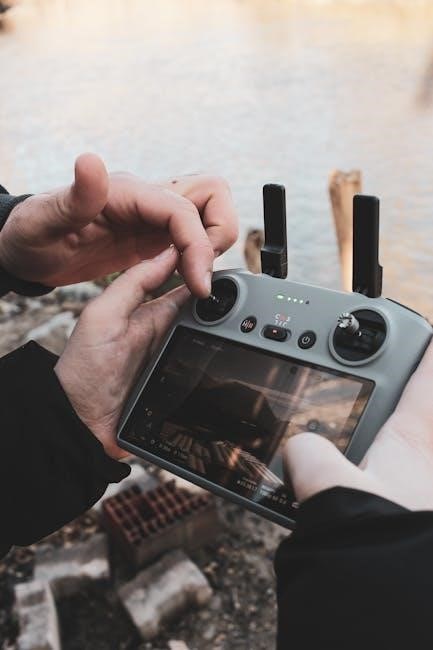
Troubleshooting Common Issues
Welcome to the troubleshooting section! This guide helps resolve common problems like connection issues, flight instability, and battery concerns. Refer to specific sections for detailed solutions.
10.1 Resolving Connection Problems
If the drone fails to connect, ensure the remote controller and drone are powered on. Check for physical obstructions and interference from other devices. Reset the drone by long-pressing the power button. Ensure the remote controller is properly paired with the drone. If issues persist, restart both devices and attempt pairing again. Verify that the drone’s firmware and app are updated. Consult the user manual or contact customer support for further assistance if problems remain unresolved.
10.2 Addressing Flight Stability Issues
If the drone exhibits unstable flight, ensure proper calibration and check for propeller damage or imbalance. Verify all parts are securely assembled. Environmental factors like wind or magnetic interference can affect stability. Restart the drone and remote controller to reset the system. If issues persist, refer to the troubleshooting section or contact customer support for assistance. Always ensure the drone is used in open, obstacle-free areas for optimal performance and stability during flight operations.
10.3 Solving Battery-Related Concerns
If the battery fails to charge, ensure the charger is properly connected and the original charging cable is used. Avoid overheating, as this can damage the battery. If the drone doesn’t power on, check the battery installation and contacts for cleanliness. For discharged batteries, allow them to cool before recharging. If issues persist, refer to the troubleshooting section or contact customer support. Always follow the recommended charging procedures to maintain battery health and ensure optimal drone performance.
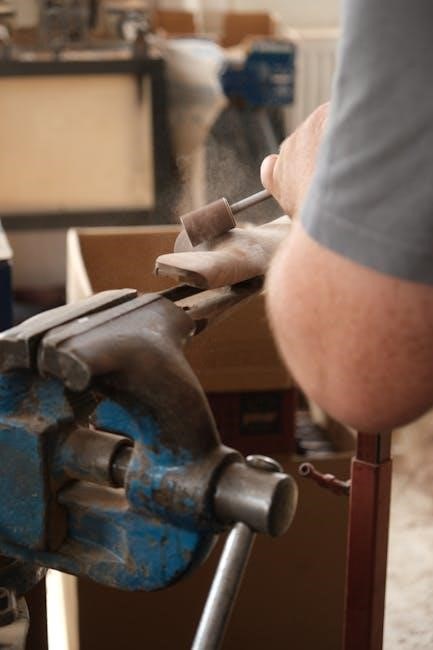
Legal and Regulatory Considerations
Ensure compliance with local drone laws, including no-fly zones and age restrictions. Always verify regulations before flying and avoid restricted areas for safe and legal operation.
11.1 Understanding Local Drone Laws
Understanding local drone laws is crucial for legal and safe operation. Regulations vary by region, often restricting flights near airports, government buildings, or crowds. Many areas require pilot registration or licenses. Ensure compliance with altitude limits, typically below 120 meters. Additionally, some regions prohibit flights over private property without permission. Always check local aviation authority guidelines before flying to avoid legal issues and ensure responsible drone usage.
11.2 Flying in Restricted Areas
Flying in restricted areas is illegal and poses significant safety risks. Restricted zones include airports, military bases, government buildings, and sensitive installations. Violating these restrictions can result in legal penalties, fines, or confiscation of the drone. Always consult local drone laws and use apps to identify restricted areas. Ensure compliance with all regulations to avoid legal consequences and maintain safe flying practices. Respecting these boundaries is essential for responsible drone operation and public safety.
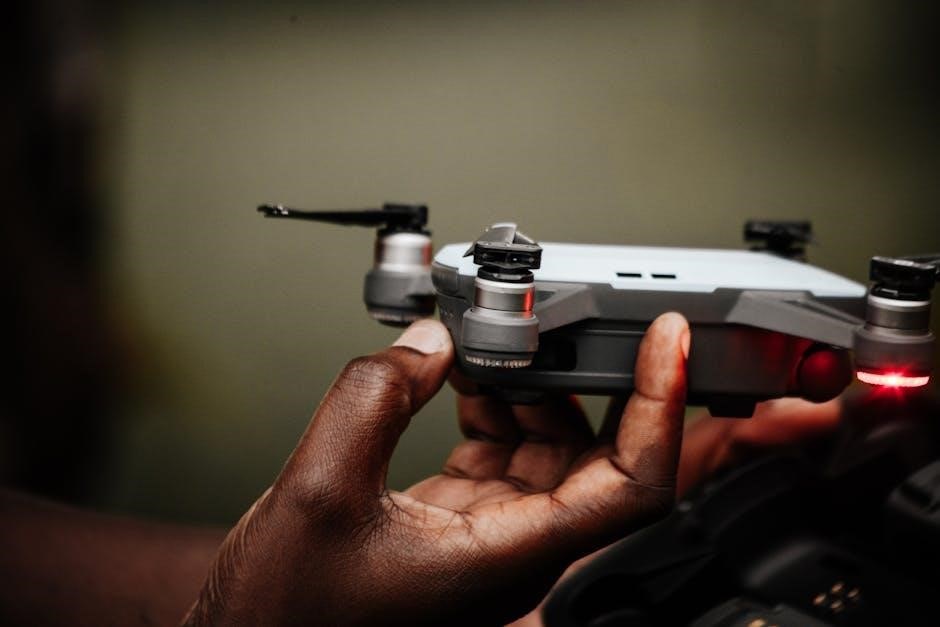
Downloading and Using the E88 Drone App
Download the RC FPV app from the app store or Google Play. This app enables real-time video transmission, flight control, and access to advanced drone settings.
12.1 Installing the RC FPV App
To install the RC FPV app, search for “RC FPV” in the app store or Google Play. Download and install the app to enable drone connectivity. Once installed, open the app and allow necessary permissions for proper functionality. Ensure your device is compatible with the app to avoid any issues. After installation, the app will guide you through pairing with the drone for real-time video transmission and flight control.
12.2 Navigating the App Interface
The RC FPV app features an intuitive interface designed for easy navigation. Upon opening, you’ll see a main dashboard with options for video feed, flight controls, and settings. The control panel includes a joystick for directional movement and buttons for takeoff/landing. The camera feed displays real-time footage from the drone’s camera. Additional icons allow access to settings, video recording, and photo capture. Users can also view battery levels, signal strength, and flight telemetry. Explore the menu to customize settings and optimize your flying experience.
12.3 Using the App for Flight Control
Using the RC FPV app for flight control provides a seamless experience. Start by connecting your drone via WiFi, then open the app and navigate to the control screen. The virtual joystick allows for precise directional control, while buttons enable takeoff, landing, and emergency stop. Predefined commands like one-key return simplify navigation. Adjust settings such as speed and sensitivity for optimal performance. The app also displays real-time telemetry, ensuring you monitor flight status effectively. Practice in open areas to master app-based control for a smooth and enjoyable flying experience.
Mastering the E88 drone requires practice and patience. Always follow safety guidelines, ensure proper maintenance, and explore advanced features for enhanced performance. Happy flying!
13.1 Summary of Key Points
This manual has guided you through the E88 drone’s features, setup, and operation. Key points include safety precautions, proper charging, flight controls, and camera usage. Regular maintenance ensures longevity, while troubleshooting addresses common issues. Practice flight techniques and explore advanced modes for better performance. Always follow local regulations and store the drone safely. Refer to this manual for detailed instructions and enjoy a smooth, enjoyable flying experience with your E88 drone.
13.2 Best Practices for Long-Term Use
Regularly clean the drone and camera to maintain performance. Store the drone in a dry, cool place away from direct sunlight; Check propellers for damage before each flight. Avoid overcharging the battery and ensure proper storage when not in use. Update the drone’s firmware and app periodically for optimal functionality. Follow all safety guidelines and local regulations to ensure safe and enjoyable flights. By adhering to these practices, you can extend the lifespan of your E88 drone and enjoy consistent, high-quality performance.

About the E88 Drone
The E88 Drone is a portable, foldable quadcopter designed for aerial photography and recreational flying, featuring a 4K camera, Wi-Fi connectivity, and user-friendly controls for beginners and pros alike.
14.1 Manufacturer Information
The E88 Drone is manufactured by ProFlight, a company known for producing high-quality, user-friendly drones. ProFlight specializes in designing quadcopters with advanced features like 4K cameras and foldable designs. Their products cater to both hobbyists and professionals, ensuring a seamless flying experience. The E88 Drone series is part of their lineup, offering a balance of performance, portability, and affordability. ProFlight adheres to strict safety and quality standards, making their drones a popular choice globally. This manual is designed to help users maximize their E88 Drone experience.
14.2 Customer Support and Resources
ProFlight offers comprehensive customer support for the E88 Drone, ensuring a smooth user experience. For inquiries, users can contact their support team via email or through the official website. Additionally, ProFlight provides a detailed FAQ section, troubleshooting guides, and a community forum for peer-to-peer assistance. The E88 Pro Drone App Guide is also available for download, offering in-depth tutorials and setup instructions. Customers can further access warranty information and repair services through ProFlight’s official channels. This extensive support system ensures users can resolve issues promptly and make the most of their drone experience.

